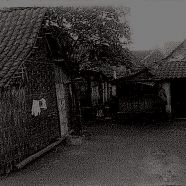
The kampong in Surabaya, Indonesia, where the Peacocks lived in 1963. Photo by Jim Peacock.
Share This
Print This
Email This
Gestapu
“Gestapu” is the Indonesian term for the massacre of one million alleged Communists in 1965 as well as a play on the term, “Gestapo.” The massacre and imprisonment of these Communists erased the third-largest Communist party in the world. Two films The Year of Living Dangerously and, recently, a documentary The Act of Killing depict the horrors during that period. One significant aftermath of the Gestapu was that President Sukarno, who died in 1970, was replaced by General Suharto, the man who led the killings and then launched the new epoch (Zaman Baru).
Sanyoto was my best friend in Surabaya, Indonesia, in 1963. He was a working-class Javanese who lived in a kampong “slum” (as did my wife and I) with his wife and his child Eki de Juni. Sanyoto, a journalist and poet, directed a proletariat theater group called “ludruk.” (See Peacock, Rites of Modernization, University of Chicago Press, 1968.) His ludruk troupe was connected to Lekra, a Communist-affiliated cultural organization. Owing to his work, Sanyoto won a scholarship to go to Moscow, where he wrote me about the thrill of seeing the Bolshoi ballet there, in 1964.
On New Year’s Eve in 1970, I returned to Indonesia, now that Gestapu had ended and Suharto’s “new era” had begun. I traveled to Surabaya and met with Sanyoto. He told of his return to Indonesia from Moscow during Gestapu. Because of his Communist-related activity, he was in danger of being categorized as a Communist and therefore killed. He survived by hiding but was disqualified from government jobs and sold pencils on the street to support his family. For many years my wife and I contributed to that support. Each time we transferred a contribution, Sanyoto’s wife would write a formal letter of thanks. After many years, when their son Eki di Juni had grown up, the letters stopped and we never heard from Sanyoto again. I presumed he was dead.
Recently, three news items appeared that prompted me to remember this period and to write this essay. The New York Times wrote about a house in Los Angeles owned by Bambang, son of General then President Suharto. It was priced at over thirty million dollars. An obituary reported that Benedict Anderson, a searing critic of Gestapu and the Suharto regime, in fact so searing that he was banned from ever returning to Indonesia, had died. It turned out that several years ago Benedict spoke, at my invitation, at a conference in Chapel Hill, North Carolina, that focused on memory in the U.S. South. In his talk he compared Indonesia after Gestapu to the U.S. South after the Civil War. In Indonesia under Suharto, he said, memory of Gestapu was suppressed. In the South, by contrast, memory of the Civil War was glorified especially by Southerners as the lost cause and a tragic destruction of antebellum civilization, memories now “gone with the wind.”
Recently, the London Review of Books published a chapter from Anderson’s forthcoming memoir. In passing, he critiqued my study of ludruk because it followed theories of Talcott Parsons, whom one might term “neoliberal” in comparison to Marxists or others who might favor revolution over modernization or rationalization as a mode of change. Evidence that Anderson was right could be provided by what I did after Gestapu when I returned to Indonesia in 1970. I researched a modernizing, though fundamentalist, Muslim group, Muhammadiyah, now reporting thirty million members in Indonesia. Some commentators even assume I had become a Muhammadiyan, which I did not—though I respected their efforts to build a workable organization in a time of violent history.
“When they’re dead you like them all,” pronounced John, one of my former coworkers in Georgia. Sanyoto and Anderson and a million others suffered from Gestapu. Memory of all tragedies, including the Gestapu and the U.S. Civil War, passes through the generations. Let us mourn and love those who suffered and suffer still.







Did Talcott Parsons play any role (or have a hand) in the training of the so-called Berkeley Mafia of Suharto’s Indonesia? I understand that the Indonesian economists comprising the Berkeley Mafia not only studied at Berkeley but also MIT, where Rostow was, and Harvard, where Parsons was. I don’t know if Parsons can be considered a key figure in the rise of the Berkeley Mafia though.